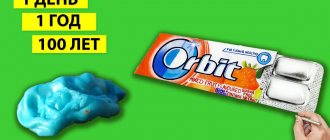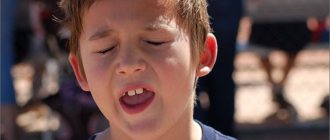Reasons for swallowing
The results of statistical studies indicate that every year millions of children find foreign objects in their gastrointestinal tract. How do they get into the body of babies? Did your child swallow a small plastic part? What to do? Why do such situations arise? Kids are inquisitive, they want to taste everything they can get their hands on. They do this sometimes and absolutely by accident during the game. Attention! Parents should keep needles, medicines, and sharp objects away from their children, seal toys with batteries with tape, and do not give children under three years of age toys that the child can disassemble into individual elements.
A child has swallowed a foreign object: what to do?
As you can see, the baby’s behavior and symptoms will depend on the size, shape, and material of the object that the child swallowed. If you suspect the presence of a foreign body in the gastrointestinal tract, the first step should be to resolve the issue of transporting the baby to the hospital as soon as possible. It is urgent to call an ambulance and take the child to a hospital, preferably to a multidisciplinary one, which has surgical, X-ray, endoscopic, and ultrasound departments available around the clock. In Moscow these are Izmailovskaya Children's City Clinical Hospital, Filatovskaya Children's City Clinical Hospital, St. Vladimir Hospital, etc.
Before the ambulance arrives, parents do not need to make any attempts to pull out, shake out, or “push” the foreign body further into the stomach (for example, by giving the child bread). Your actions can only cause harm. You cannot feed or give water to your baby, including breast milk. You can moisten your lips with water if they are dry. We must try, if possible, to calm the baby down and collect the necessary documents for the hospital: medical insurance for the child and mother.
If the baby is coughing, choking, or choking, you can tap the edge of your palm or your fingers on his back between the shoulder blades, directing the blows from bottom to top, throwing the baby over your knee so that the upper body is lowered. A child under 1 year of age is placed face down on the arm, the head is slightly lowered, the index or middle finger of the “supporting” hand is placed in the child’s mouth, opening it, and the back is patted with the free hand. This should not be done if the baby is able to breathe, as sharp pats may dislodge the object in such a way that it blocks or causes swelling in the airway, making breathing very difficult. Do not forget that the main goal of the actions taken is to make breathing easier (if it is difficult). If there is no difficulty breathing, then you should wait for the ambulance to arrive.
What do children swallow most often?
All objects that may end up in the gastrointestinal tract of a small child are conventionally divided into two groups: dangerous and non-hazardous to health. The first group includes:
metal products (coins, batteries, magnets, foil, screws, balls, nails);
long or sharp objects (paper clips, wooden toothpicks, fish bones, glass, nails);
poisonous and toxic substances.
Some foreign bodies do not pose a direct danger. Such items include fruit pits, plastic parts, and a lost tooth.
Non-hazardous foreign objects are:
pits from plums, cherries, peaches, chewing gum; rubber and polymer objects (beads, buttons, cellophane);
building materials (silica gel, polyurethane foam);
hair, teeth;
other products (cotton wool, threads, hair bands).
What happens to swallowed objects in the body?
The vast majority of objects - even sharp ones - pass independently through the esophagus, stomach and intestines and are eliminated from the body without causing harm. The chances of safe passage of a foreign body increase if it overcomes the most “problematic” section of the gastrointestinal tract – the esophagus. Less commonly, foreign bodies become lodged in the stomach or intestines (including the rectum) or pierce their walls and penetrate other organs.
Complications also include damage to the pleura by sharp foreign bodies (this can lead to air entering the chest), erosion of the mucous membrane of the gastrointestinal tract.
Sequence of parental actions
The main symptom indicating that a small child has swallowed a plastic part with sharp edges is difficulty breathing. How should parents behave in such situations? We offer an algorithm of simple actions, the observance of which will allow you to provide first aid to the baby. So, your child has swallowed a plastic part, what should you do? The maximum danger to the baby is posed by any foreign parts found in the trachea or respiratory tract. What should adults do in such situations:
1. You need to carefully throw the child over your left knee. The baby's head should be down.
2. You need to pat his back, between the shoulder blades.
3. It is advisable to induce an emetic effect by pressing on the root of the tongue.
Parents should understand how dangerous small parts can be for their child and should not allow the baby to come into direct contact with them.
Not all mothers and fathers know what to do. A child swallows a plastic part, suffocates, and adults often simply panic. But you cannot hesitate for a minute, as the baby may be in serious danger. If you wait until the foreign object leaves the body on its own, there is likely to be a serious threat to the child’s life. Parents, seeing that the baby’s behavior has changed, should try to find out the cause of coughing, wheezing, and changes in complexion. If the child is not provided with qualified assistance in a timely manner, sad consequences will be inevitable. Swallowing a small piece from a children's construction set can only be harmless if it is of the correct shape and small in size. Otherwise the situation could be serious. If a child swallows a sharp plastic part, as it passes through the gastrointestinal tract, it can injure internal organs, promote inflammation, and provoke bleeding. Only if you consult a doctor immediately can you count on maintaining your baby’s health.
How not to cause harm
If parents do not keep an eye on the baby, what should they do? A child has swallowed a plastic part and is suffocating, what is the right thing to do so that the assistance provided does not cause additional harm to him? Of course, to begin with, it is important to remain calm so that the child does not feel the full danger of the situation.
It is strictly prohibited:
1. Give the baby laxatives and give enemas, since artificially accelerating the functioning of the digestive system can lead to negative consequences. The object can injure internal organs and get stuck in the intestines.
2. You should not force your child to eat solid food.
3. You cannot try to remove a foreign body yourself using a magnet or tweezers.
If a one-year-old child swallows a plastic part smaller than a centimeter in size and having a round shape, there is a high probability that the foreign body will pass through the gastrointestinal tract on its own along with the stool. You need to be patient, remembering to observe the child’s behavior.
Foreign body symptoms
After ingestion, a foreign body may not manifest itself in any way: more often such objects pass through the digestive tract asymptomatically. Pathological manifestations develop when they get stuck.
Foreign body in the esophagus
If a foreign body becomes stuck, it usually occurs in the esophagus. In such cases, the person may feel like they are choking. The following symptoms may appear:
- difficulty swallowing;
- sensation of a foreign object in the throat or chest (if the object is blunt);
- pain in the throat or chest (if the object is sharp);
- retching, nausea;
- cough, noisy breathing;
- excess saliva;
- blood in saliva.
Foreign body in the stomach or intestines.
- pain and/or cramps in the abdomen;
- flatulence;
- bloating;
- loss of appetite,
- nausea, vomiting;
- fever;
- blood in feces;
- diarrhea or constipation.
Foreign body in the rectum
Sometimes a foreign body can travel almost the entire gastrointestinal tract, but become stuck in the rectum. In such cases, there may be acute pain during bowel movements, and blood may be found in the stool.
Qualified help
If a child has swallowed a plastic part of a toy, which can pose a real danger to him, he must be hospitalized. In the hospital, using an X-ray or ultrasound examination, a specialist will identify the place where the part is “stuck”. If a small object gets into the stomach, it can be eliminated after research. If a foreign part gets into the bronchi, the doctor will work under anesthesia, since his manipulations can cause pain in the baby. In order to prevent infection of the bronchi and lungs, the doctor may additionally prescribe a course of antibiotics.
The exact location of a foreign object in the body can only be determined through research.
When to ask for help?
Medical help should be sought if a child has swallowed a dangerous object: large, sharp or toxic (see list). A specialist is also required if the child cannot swallow, has the urge to vomit, has abdominal pain, blood in the vomit or stool, has developed a severe cough, or has a deteriorating general condition. Consultation is required if the foreign body has not been passed in stool within three days.
Adults are advised to seek emergency care in case of chest pain, acute abdominal pain, difficulty swallowing or difficulty breathing, bloody vomiting (or vomiting “coffee grounds”), or blood in the stool.
Consequences
If parents do not consult a doctor in a timely manner, a foreign object found in a child’s body can lead to a number of negative consequences: intestinal obstruction, internal bleeding, and death. If your baby has swallowed small plastic parts, there is no cause for special concern. Polymer substances are resistant to gastric juice; they retain their properties when temperature changes. Small plastic parts from the designer do not oxidize and do not emit toxic substances. A serious problem will only arise in situations where the part has a complex shape (sharp corners), since when it moves through the intestines, the mucous membrane will be irritated, and the intestinal tube may spasm. In some cases, there is a threat to the child’s life due to the development of acute intestinal obstruction; without emergency medical care, death is possible.
Clinical manifestations
Intestinal obstruction, which occurs when a child swallows foreign parts, can cause organ perforation. If an object ends up in the windpipe, a serious condition occurs, which is associated with blockage of the larynx. The child begins to choke, and if help is not provided in a timely manner, the baby may die. There is a certain set of symptoms that cannot be confused with other situations: severe coughing attacks, blue or pale face, excessive salivation. If a small object ends up in the digestive system, pathological manifestations may not occur. The baby maintains his usual activity, there are no alarming signals in his behavior. The foreign object will leave the body naturally without causing serious problems to the baby.
Let's sum it up
What should parents do if their baby swallows a foreign object while playing? Without wasting a single second, you need to call an ambulance. If the baby’s condition is satisfactory, parents can take him to a medical facility themselves to save precious time. Pediatricians do not recommend that mothers and fathers take out the object on their own, armed with improvised means, for example, tweezers or a clamp. Such manipulations can damage the baby’s organs and cause even greater harm to his health.
Health to you and your children, dear readers and subscribers!








